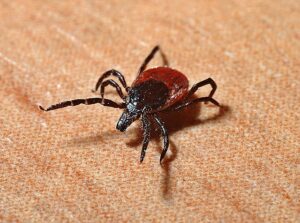Many people have started using kratom for Lyme disease. But what is the best way to use kratom? How can kratom help Lyme patients? In this article, we will explore how kratom works and what it can do to relieve the symptoms of Lyme disease.
What Is Lyme Disease?
Lyme disease is a condition caused by the bacteria Borrelia burgdorferi. This bacterial species is transmitted through the bite of an infected black-legged tick or deer tick.
Traditionally, Lyme disease has been more frequent in Northeast states. However, today you can find cases of this disease in all states and Canada.
Symptoms of Lyme Disease
The early symptoms of Lyme disease include fatigue, headache, joint pain, fever, chills, and swollen lymph nodes. But the most common symptom of Lyme disease is a peculiar rash called erythema migrans. Erythema migrans occurs in roughly 70 to 80 percent of Lyme disease cases. It is a red rash with a round shape, like a bull’s-eye. This rash often grows and spreads through the skin. If you experience these symptoms you should visit your doctor immediately.
If Lyme disease is not treated, the symptoms worsen and can have serious long-term consequences for your overall health. Late symptoms of Lyme disease include:
- Arthritis
- Chronic or intermittent pain
- Fatigue
- Insomnia
- Cognitive issues
- Confusion
- Facial palsy
In some cases, Lyme disease might result in fibromyalgia.

How Does Kratom Work?
Users of kratom favor this Asian plant for its multiple effects. Kratom (Mitragyna speciosa) is a tree in the coffee family that grows in the humid regions of Thailand, Indonesia or Vietnam.
Thousands of people across the world now consume kratom leaves —dried and ground to a fine powder— to cope with many ailments and conditions, ranging from pain to fatigue. But how does kratom work?
Kratom possesses alkaloids that act on the opioid receptors in your body. If you are wondering if these receptors have something to do with opiates, the answer is yes. Opiates bind to these receptors, but there are other substances or products, like kratom itself or cheese, that do exactly the same thing. Our body also produces its own endogenous opioids, that also activate the opioid receptors.
When kratom alkaloids bind to the opioid receptors, your body responds by generating a series of effects, such as:
- Analgesia (or pain relief)
- Relaxation and stress relief
- Stimulation
- Euphoria
- Focus and concentration improvement
That’s why people consume kratom to cope with:
- Pain
- Anxiety
- Stress
- Depression
- Insomnia
- Fatigue
- Poor concentration
Benefits of Kratom for Lyme Disease
People suffering from Lyme disease can find a great ally in kratom’s analgesic properties. Many kratom users consume this herb to cope with chronic pain, for example, arthritis pain or fibromyalgia pain. Most of these users report that kratom is so effective as conventional painkillers. But unlike many painkillers, kratom is not an addictive substance and its side effects are not dangerous. Therefore, if you are suffering from pain due to Lyme disease, you could find relief in kratom.
But kratom’s energizing properties can also be very helpful for Lyme patients. Fatigue is a common symptom of Lyme disease, and kratom can give you an energy boost without the jitters of coffee.
Also, kratom provides you with a sense of wellbeing thanks to its relaxing and euphoric effects.

Kratom Types for Lyme Disease
If you want to use kratom for Lyme disease, you must first learn some basic facts about kratom. There are three major kratom types:
- White kratom: Its effects are more energizing and euphoric.
- Red effects: Its effects are more analgesic and calming.
- Green kratom: It has analgesic, euphoric, energizing, and relaxing effects. However, green kratom strains are usually milder than the red and white varieties.
If you want to use kratom to relieve pain, red strains are usually the right choice. Red strains are usually regarded as the best kratom varieties for pain. Nonetheless, all kratom strains have analgesic effects. Hence, if you also want to combat fatigue, white strains could also be a great choice. Green strains are also favored when looking for a more balanced range of effects. Also, in general kratom is more energizing at low doses and more sedative at high doses.
What Is the Right Kratom Dosage?
If you are new to kratom, it is recommendable you start with a 2-3 grams dosage. If you don’t feel any effects after 30-40 minutes you can take 0.5 grams extra.
A 2-4 grams dosage is usually regarded as a low dosage. It is a good dosage if you want to get a light energy boost.
If you are looking for analgesic but also energizing effects, a moderate dosage of 4-5 grams may be the best choice for you.
Doses higher of 5 grams can cause sedative effects, and while they will provide potent pain-relieving effects, they can also cause dizziness and an unpleasant sedation feeling.
Avoiding high doses is key to prevent kratom side effects, which include:
- Nausea
- Migraines and headaches
- Constipation
- Dizziness
- Dehydration
- Eye wobbles
You should also avoid consuming kratom every day. A frequent kratom use (especially at high doses) can easily result in kratom tolerance. If you experience tolerance, you will need higher doses in order to feel its effects.
So, if you want to use kratom for Lyme disease, you should use a cautious, moderate approach.


